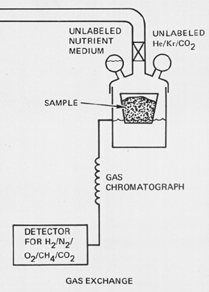Introduction
Definition of Life
Motivation
Preliminary
Steps
Present Life
Past Life
Geological Survey
Sample Collection
Spectroscopic Analysis
Organic Analysis
Biology Experiments
Thin Section
Isotope Analysis
Experimental Design
Gas Exchange Experiment
Brief Synopsis
This gas exchange experiment (GX) was based on the assumption that
life consisted of heterotrophic micro-organisms requiring the presence of
or direct contact with organic substrates and possibly various organic
growth factors for their metabolism, and that metabolism would involve the
uptake or release of metabolic gases.
Therefore, this experiment called for a thick mixture consisting of
many organic compounds both in the solution and in the vicinity of the
solution and tested for the evolvement of gas from the sample.
This experiment was also designed to distinguish between those
gases that emerged from nonbiological processes from those that emerged
form biological processes. Again,
the validity of this experiment was greatly undermined by the sample type
and could be corrected by being more conservative in sample selection.
Equipment
- Viking composite instrument (VCI) with a gas chromatograph (GC)
- Nutrient “soup” – complex aqueous solution, containing 19 amino acids and over a dozen growth factors, plus numerous inorganic salts
- Test gas to pressurize the chamber including (91.65% He, 5.51% Kr, and 2.84% CO2)

Protocol
The protocols for the GX experiment consist of three different modes: dry (control), humid, and wet. The experiment is divided up into four sequences:
Initialization Sequence:
n place 1cc soil in sample chamber
n add the test gas
n do one of the three options for the three modes
- add no moisture
- add enough nutrient to humidify sample (» 0.5cc)
- add enough nutrient to wet the soil (»2 cc)
n incubate the sample with nutrient at 145°C for 3.5 hours
Recharge Sequence:
n flush the test gas from chamber using He gas
n add more nutrient along with fresh test gas
Termination Sequence:
n flush the test gas from the chamber
n leave open to dry for 3 sols (Martian day»24.5 hours)
Heat treatment sequence:
n after flushing test gas from chamber, add fresh soil sample
n incubate at 145°C for 3.5 hours with 1cc/min He flowing through
n measure the gas types evolved using the GC
The GC measures the amount of H2, Ne, N2, O2, Ar, or CO, NO, CH4, Kr, CO2, N2O, H2S.
Viking Results
The GC results that every gas except O2 exhibited the same level as the control indicating that no change had occurred. The increase in O2 seemed to indicate that some heterotrophic organism produced it upon contact with the thick nutrient medium.
Problems
Another viable reason for the evolution of more O2 was the presence of peroxides and superoxides in the soil. Upon contact with moisture, these compounds could have produced O2 and are therefore not evidence of life. In addition, the rapidity of the gas evolvement seems indicative that the reaction was a chemical one and not a biological one.
Alterations made to the protocol:
Basically, the sample collected needs to be devoid of peroxides or superoxides. This is the main reason the GX experiment produced results for O2 and no other gaseous molecule.
Sources
Levin, Gilbert V. and Patricia Ann Straat, “Recent Results From the Viking Labeled Release Experiment on Mars.” Journal of Geophysical Research. Vol. 82, No. 28 September 30, 1977.
Carr, Dr. Michael H. and Benton Clark et al. “An Exobiology Strategy for Mars Exploration.” Online: http://cmex.arc.nasa.gov/MarsNews/mars_papers/Docs/mars_strat.html
NASA, “Science on Mars.” Online: http://history.nasa.gov/SP-4212/ch11-5.html
Caplinger, Michael. “Life on Mars.” Online: http://barsoom.msss.com/http/ps/life/life.html
For a handy semi-animation of this experiment, go to http://cybooks.com/ahill3/hill03.html